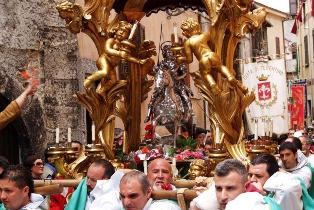
 Umberto Mucci
Umberto Mucci
Italian religious events: Feast of Saint Ambrose, Ferentino
- WTI Magazine #27 Apr 24, 2014
-

 Umberto Mucci
Umberto Mucci
WTI Magazine #27 2014 Apr, 25
Author : folclore.it Translation by:
Ferentino, in the province of Frosinone in the southern part of Lazio, celebrates the Feast of St. Ambrose, its patron saint, on April 30. The route of the procession of St. Ambrose, lit by torches, lanterns and lamps, is daunting: between narrow and ancient streets, in a succession of ascents and descents, with people gathered on the edges, the 600 kg statue of the saint is transported by 11 teams of 16 young "incollatori" (literally: those who put the glue), which shift along a three-hour hike through all the districts of the town.
At the end of the procession, the crowd reaches the Church of SS. John and Paul, built on the Acropolis where the legend says the saint had been taken prisoner.
St. Ambrose, a Roman soldier who converted to Christianity, was imprisoned, tortured and then killed by his own commander, the principal Daciano Publius, who discovered his own conversion during a campaign of persecution against Christians began by order of Diocletian, while he was with the army in Ferentino.
The population loves the patron saint and the devotion to St. Ambrose has always been fierce. The message left by this saint is about the "sequel without yielding towards Christ". A message that every citizen of Ferentino has in his/her growing up as a kid. The tradition of the "incollatori" has been handed down from father to son, and all Ferentino gather around with passionate feeling in this holy feast day.
The participation of citizens can already be seen for the Novena (a series of prayers) which begins on April 21. Every evening a catechesis and a prayer to the saint, attended by all eleven fraternities of the city and by secular and civic and sports associations, vouches for the strong and intimate participation of the population and the fervent devotion to the saint.
Palpable emotion that the city also conveys to visitors and that transcends time and from year to year, from generation to generation, is passed on and grows stronger.